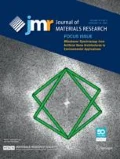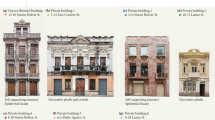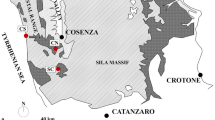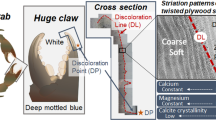Abstract
Techniques from the field of materials science and engineering were utilized to examine the mechanical effects of dark pigment in exoskeleton material on the distal portion of stone crab, Menippe mercenaria, chelae. We made specimens from dark-and light-colored exoskeleton material to measure hardness and fracture toughness. The results from these tests showed the dark material to be much harder and tougher than light-colored material from the same crab chela. Scanning electron microscope photographs are presented to document the microstructure and level of porosity. We think that the structural difference in material properties is due to the lower level of porosity and phenolic tanning in dark material and that this tanning caused the dark color and filling of porosity. The exoskeleton structure is a laminated organic-inorganic structure which can serve as a model for self-healing structures.
Similar content being viewed by others
References
E. H. Burtt, An Analysis of Physical, Physiological, and Optical Aspects of Avian Coloration with Emphasis on Wood-Warblers, Ornithological Monographs No. 38 (The American Ornithologists’ Union, Washington, DC, 1986).
T. Say, J. Acad. Natural Sciences of Philadelphia 1 (2), 448 (1818).
E. S. Bender, M. S. Thesis, University of Florida, Gainesville, FL (1971), 110 pp.
R. Roer and R. Dillaman, American Zoologist 24, 893–909 (1984).
W. Ghidalia, Structural and Biological Aspects of Pigments in the Biology of Crustacea, edited by D. E. Bliss and L. H. Mantel (Academic Press, Orlando, FL, 1985), Vol. 9, pp. 301–394.
G. F. Warner, The Biology of Crabs (Van Nostrand Reinhold Company, New York, 1977).
J. Vincent, Structural Biomaterials–Rev. ed. (Princeton University Press, Princeton, NJ, 1990).
G. Krishnan, Quarterly J. Microscopical Sci. 92, part 3, 333–342 (1951).
T. Savage and J. R. Sullivan, Growth and Claw Regeneration of the Stone Crab, Menippe mercenaria (Florida Marine Research Publications, Florida Department of Natural Resources, 1978), No. 32, 23 pp.
Annual Book of ASTM Standards, Part 17, Refractories, Glass, and Other Ceramic Materials: Manufactured Carbon and Graphite Products (American Society for Testing and Materials, Philadelphia, PA, 1974), pp. 103–106.
Annual Book of ASTM Standards, Part 10, Metals—Mechanical, Fracture, and Corrosion Testing; Fatigue; Erosion; Effect of Temperature (American Society for Testing and Materials, Philadelphia, PA, 1978), pp. 271–281.
P. Chantikul, G. R. Anstis, B. R. Lawn, and D. B. Marshall, J. Am. Ceram. Soc. 64 (9), 539–543 (1981).
B. S. Welinder, Comp. Biochem. Physiol. 52A, 659–663 (1975).
Author information
Authors and Affiliations
Rights and permissions
About this article
Cite this article
Melnick, C.A., Chen, Z. & Mecholsky, J.J. Hardness and toughness of exoskeleton material in the stone crab, Menippe mercenaria. Journal of Materials Research 11, 2903–2907 (1996). https://doi.org/10.1557/JMR.1996.0367
Received:
Accepted:
Published:
Issue Date:
DOI: https://doi.org/10.1557/JMR.1996.0367




